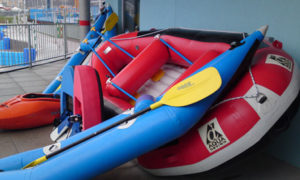Whitewater rafting attracts thousands of participants every year. Whitewater rafting can be safe and fun for the whole family, from the beginner to the advanced paddlers. A simple guide rafting Whitewater guide follow:
Classification of Rapids:
Class I – Easy. Small waves in fast moving water. Few obstacles.
Class II – Novice. Wide channels and rapids that are easy to navigate, without many turns or obstacles. Small waves less than two feet high.
Class III – Intermediate. Strong currents require training and ability to maneuver quickly and effectively. From this class on, rafters require a guide. Not suitable for young children.
Class IV – Advanced. Powerful rapids for strong paddlers that can handle fierce turns and spins. Drops and waves are common.
Class V – Expert. Violent, dangerous rapids, usually through obstructed channels, tight turns, and soaring falls. Requires professional equipment.
Class VI – Unrunnable. Likelihood of death in attempting class 6 runs.
Types of Crafts
Kayaks – Kayaks designed for whitewater are usually shorter than sea kayaks and most are made of plastic (although fiberglass kayaks are popular among racers).
Rafts – The preferred type of craft for large groups, they are made of inflatable plastic, and can handle almost any type of current.
Catarafts — Similar to rafts but easier to maneuver, they consist of two inflatable tubes held together by a frame.
Canoes — Made of fiberglass or plastic, they can handle an Eskimo roll the same way kayaks do.
Guide Rafting Whitewater
Fall has always been one of the most amazing months for rafting, to add to the incredible scenery, bears, mountain goats, deer, and cougars are often seen along the way. Also, during lower flow times, the big hits and tight, technical maneuvers make for a very exciting ride!”
Summer rafting is usually more calm, due to lower water volume. Some rivers provide daily dam releases from May through early October; others take advantage of melting snow (which increases water flow).
What to Bring
This varies according to the season and the company offering the trip –Some places have very specific outfit rules, and they provide some of the items in the list below, so it’s always better to ask in advance. Some basics you need include:
* Wetsuit (in spring and fall); bathing suit or shorts (summer)
* Wetsuit booties or strapped sandals (no flip-flops)
* Pogies (special gloves to use when dealing with cold water)
* Polypropylene t-shirt (avoid cotton, as it takes a long time to dry)
* Wool socks and a windbreaker in spring and fall
* Waterproof sunscreen
More Items to consider
* Bug spray
* Sunglasses (with neck strap)
* Disposable waterproof camera (do not bring any expensive equipment)
* First aid kit (if you’re not going with a group)
* Fresh Water
* Depending on the location, the water may be cold even in May, so make sure you ask beforehand so you can decide what to wear.


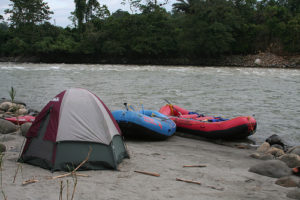 Almost every state and province in North America offers combined cabin rafting rental whitewater combinations for whitewater rafting vacations. Pick your location based on available cabins or whitewater rafting opportunities, it does not matter. You will have a great time, great memories of the Whitewater excursion and camping out in your cabin in the wilderness.
Almost every state and province in North America offers combined cabin rafting rental whitewater combinations for whitewater rafting vacations. Pick your location based on available cabins or whitewater rafting opportunities, it does not matter. You will have a great time, great memories of the Whitewater excursion and camping out in your cabin in the wilderness. Whitewater River rafting is a very popular sport that thousands of people take part in every year across the nation. Many rafting river whitewater companies have trips that are available for the beginner. They also have trips for the expert who is looking for the extreme challenge that a class 5 white water rapids offers. These companies offer half day whitewater trips as well as all day trips. Overnight rafting trips that take you into the wilderness were you can see fantastic scenery and wildlife are also available. So how do you select a whitewater rafting company?
Whitewater River rafting is a very popular sport that thousands of people take part in every year across the nation. Many rafting river whitewater companies have trips that are available for the beginner. They also have trips for the expert who is looking for the extreme challenge that a class 5 white water rapids offers. These companies offer half day whitewater trips as well as all day trips. Overnight rafting trips that take you into the wilderness were you can see fantastic scenery and wildlife are also available. So how do you select a whitewater rafting company?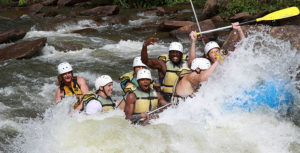 There are many whitewater rafting trips in virtually every state and province in North America, not far from most major urban centers. Rafting trip whitewater trips have become very popular for families, seniors as well as the extreme adventure tourist. Of course the more challenging the whitewater rapids are, the more equipment and skills you need. All of this is needed to make sure that you will have a successful and safe trip.
There are many whitewater rafting trips in virtually every state and province in North America, not far from most major urban centers. Rafting trip whitewater trips have become very popular for families, seniors as well as the extreme adventure tourist. Of course the more challenging the whitewater rapids are, the more equipment and skills you need. All of this is needed to make sure that you will have a successful and safe trip. We have written numerous articles about components of how to white water raft on this website. We have covered a variety of topics. Such as white water safety, white water etiquette, white water gear. We have many review posts about various locations that you can go white water rafting. The one thing we want to emphasize above all else is safety. Follow the instructions of your guide and if they tell you to paddle, then do it.
We have written numerous articles about components of how to white water raft on this website. We have covered a variety of topics. Such as white water safety, white water etiquette, white water gear. We have many review posts about various locations that you can go white water rafting. The one thing we want to emphasize above all else is safety. Follow the instructions of your guide and if they tell you to paddle, then do it.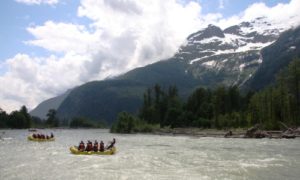
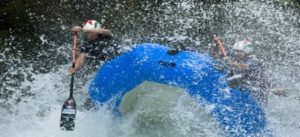

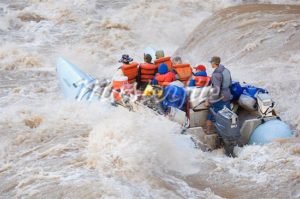

 If you are considering a first time white water rafting experience and wondering if it is right for you, we may be able to address some of your questions. Most rafting companies show pictures of extreme white water with lots of waves and foam, rafts careening down rivers which for non rafters it is an experience that looks quite challenging and perhaps scary at the same time.
If you are considering a first time white water rafting experience and wondering if it is right for you, we may be able to address some of your questions. Most rafting companies show pictures of extreme white water with lots of waves and foam, rafts careening down rivers which for non rafters it is an experience that looks quite challenging and perhaps scary at the same time.